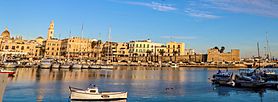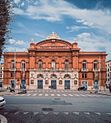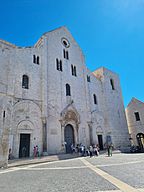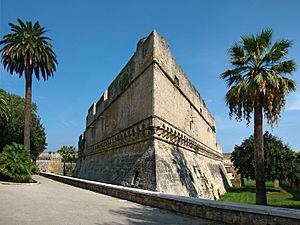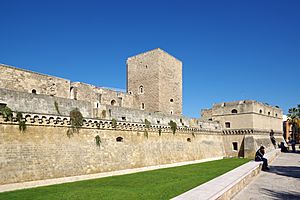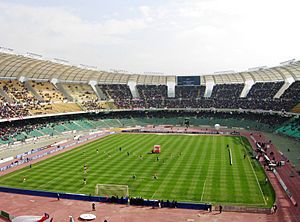Bari facts for kids
Quick facts for kids
Bari
Bare (Neapolitan)
|
||
|---|---|---|
| Comune di Bari | ||
|
|
||
|
||
| Country | Italy | |
| Region | Apulia | |
| Area | ||
| • Total | 117 km2 (45 sq mi) | |
| Elevation | 5 m (16 ft) | |
| Population
(1 January 2019)
|
||
| • Total | 316,491 | |
| • Density | 2,705/km2 (7,006/sq mi) | |
| Demonym(s) | Barese | |
| Time zone | UTC+1 (CET) | |
| • Summer (DST) | UTC+2 (CEST) | |
| Postal code |
70121-70132
|
|
| Dialing code | 080 | |
| Patron saint | Saint Nicholas | |
| Saint day | 8 May | |
Bari is a big city in southern Italy, right on the Adriatic Sea. It's the capital of the Apulia region. It's a very important city for business and trade in southern Italy, second only to Naples. Bari is a busy port city, home to a university, and famous for Saint Nicholas (yes, like Santa Claus!).
Over 315,000 people live in Bari. If you count the surrounding areas, it's home to more than 1.3 million people! Bari has different parts. The old town, called Barivecchia, is in the north, right by the sea. It has amazing old buildings like the Basilica of Saint Nicholas, the Cathedral of San Sabino, and the Norman-Swabian Castle. South of the old town is the modern part, the Murat quarter, with straight streets, a lovely seaside walk, and popular shopping streets like via Sparano. Newer neighborhoods were built around the city center in the 1960s and 70s, and even more grew quickly in the 1990s.
Contents
Bari's History
Ancient Times
Bari, once known as Barium, was an important harbor for the ancient Peuceti people. It had strong Greek influences before the Romans took over in the 3rd century BC. The city became a key trading port, connecting coastal roads and the Via Traiana. Its harbor was always important for trade and fishing. The first known bishop of Bari was Gervasius in 347 AD.
Middle Ages
After some tough times, Bari was ruled by the Longobards and Byzantines. During the Middle Ages, Bari was a major center for trading slaves in the Mediterranean Sea. Slaves were brought from places like Dalmatia, Prussia, Poland, and the Balkans. They were often sold to Muslim states around the Mediterranean.
For 20 years, Bari was even an emirate, ruled by an emir named Kalfun starting in 847. But in 871, Emperor Louis II, with help from a Byzantine fleet, took the city back. By 885, Bari became the home of the Byzantine governor.
In 1071, a Norman leader named Robert Guiscard captured Bari after a three-year siege. The famous Basilica di San Nicola was built in 1087 to house the relics of Saint Nicholas. These relics were secretly brought from Myra. Saint Nicholas became very popular, and pilgrims visiting his relics helped Bari's economy.
In 1095, Peter the Hermit preached about the First Crusade in Bari. In 1098, Pope Urban II held an important meeting called the Council of Bari. They discussed differences between the Greek and Latin churches, but they didn't agree on everything.
Early Modern Period
Bari went through a long period of decline under the Kings of Naples. However, it saw some good times under the Sforza family, especially with Duchess Bona Sforza. Bari was also ruled by Venice, which helped its port grow and made trade very successful.
In 1813, Joachim Murat, who was the King of Naples during the Napoleonic era, started a big project to rebuild Bari. He designed the city with a new "chessboard" pattern of streets, which is still seen today. This part of the city is named after him.
In 1915, clean water finally arrived in Bari thanks to the Apulian Aqueduct. During the time of Italian fascism, the city's seafront was developed.
World War II
On September 11, 1943, during World War II, British troops took over Bari without a fight. It became an important supply center for the Allied forces.
The 1943 Chemical Disaster
On December 2, 1943, German bombers attacked Bari's port. Over 20 Allied ships were sunk. One of these ships, the John Harvey, was secretly carrying mustard gas. This gas was meant to be used only if Germany used chemical weapons first.
The presence of the gas was a secret, so British doctors didn't know what they were dealing with. Many people died because they received the wrong treatment. Rescuers also got sick from touching contaminated clothes.
The harbor was closed for weeks. After the attack, a U.S. doctor named Stewart F. Alexander realized it was mustard gas. He convinced doctors to treat patients for gas exposure, which saved many lives. He also collected samples that later helped create an early form of chemotherapy.
Allied leaders kept this event a secret for many years. Records were destroyed. The story became known in 1967. The exact number of deaths from the gas is still debated, but it was a tragic event.
Charles Henderson Explosion
Another disaster struck Bari's port on April 9, 1945. The ship Charles Henderson exploded while unloading bombs. This explosion killed 360 people and injured 1,730. The harbor was closed again for a month.
Bari's Location and Climate
Bari is the largest city on the Adriatic Sea. It's in southern Italy, north of Naples and south of Rome. Bari has a Mediterranean climate. This means it has mild winters and hot, dry summers.
| Climate data for Bari Karol Wojtyła Airport (1991–2020 normals, extremes 1932–present) | |||||||||||||
|---|---|---|---|---|---|---|---|---|---|---|---|---|---|
| Month | Jan | Feb | Mar | Apr | May | Jun | Jul | Aug | Sep | Oct | Nov | Dec | Year |
| Record high °C (°F) | 24.0 (75.2) |
25.1 (77.2) |
31.6 (88.9) |
32.6 (90.7) |
39.1 (102.4) |
45.5 (113.9) |
45.6 (114.1) |
44.8 (112.6) |
39.1 (102.4) |
35.2 (95.4) |
28.7 (83.7) |
24.0 (75.2) |
45.6 (114.1) |
| Mean daily maximum °C (°F) | 12.6 (54.7) |
13.2 (55.8) |
15.7 (60.3) |
19.0 (66.2) |
23.6 (74.5) |
28.2 (82.8) |
30.6 (87.1) |
30.5 (86.9) |
26.2 (79.2) |
21.9 (71.4) |
17.6 (63.7) |
13.9 (57.0) |
21.1 (70.0) |
| Daily mean °C (°F) | 8.3 (46.9) |
8.7 (47.7) |
10.9 (51.6) |
13.9 (57.0) |
18.5 (65.3) |
23.0 (73.4) |
25.4 (77.7) |
25.4 (77.7) |
21.2 (70.2) |
17.2 (63.0) |
13.2 (55.8) |
9.6 (49.3) |
16.3 (61.3) |
| Mean daily minimum °C (°F) | 4.1 (39.4) |
4.2 (39.6) |
6.0 (42.8) |
8.9 (48.0) |
13.0 (55.4) |
17.3 (63.1) |
20.0 (68.0) |
20.1 (68.2) |
16.5 (61.7) |
12.6 (54.7) |
9.0 (48.2) |
5.8 (42.4) |
11.5 (52.7) |
| Record low °C (°F) | −7.6 (18.3) |
−3.0 (26.6) |
−5.4 (22.3) |
−0.9 (30.4) |
3.6 (38.5) |
7.8 (46.0) |
11.8 (53.2) |
12.4 (54.3) |
8.4 (47.1) |
4.0 (39.2) |
−1.0 (30.2) |
−3.6 (25.5) |
−7.6 (18.3) |
| Average precipitation mm (inches) | 50.8 (2.00) |
37.0 (1.46) |
41.0 (1.61) |
42.0 (1.65) |
30.4 (1.20) |
29.4 (1.16) |
17.8 (0.70) |
13.3 (0.52) |
41.7 (1.64) |
53.9 (2.12) |
62.0 (2.44) |
47.4 (1.87) |
466.6 (18.37) |
| Average precipitation days (≥ 1.0 mm) | 7.4 | 5.6 | 6.5 | 6.0 | 4.5 | 3.0 | 1.9 | 2.3 | 4.8 | 5.5 | 7.0 | 7.0 | 61.4 |
| Average relative humidity (%) | 71.8 | 69.7 | 69.1 | 67.8 | 66.3 | 64.2 | 60.4 | 63.3 | 68.3 | 73.2 | 74.9 | 73.1 | 68.5 |
| Source 1: NOAA | |||||||||||||
| Source 2: Servizio Meteorologico (extremes) | |||||||||||||
Bari's Neighborhoods
Bari is split into five main areas called Municipi. These were created in 2014. The city also has 17 official neighborhoods, known as quartieri.
| Code | Name | Area | Population |
|---|---|---|---|
| 1 | Municipio 1 | 24.07 km2 | 113,378 |
| 2 | Municipio 2 | 15.44 km2 | 91,303 |
| 3 | Municipio 3 | 22.51 km2 | 50,742 |
| 4 | Municipio 4 | 33.16 km2 | 38,566 |
| 5 | Municipio 5 | 21.56 km2 | 30,209 |
Famous Places in Bari
- Teatro Margherita: A historic theater.
- Teatro Piccinni: Another important theater in the city.
- Orto Botanico dell'Università di Bari: A beautiful botanical garden.
- Santa Chiara: An old church that now holds a museum.
- The Acquedotto Pugliese: A large aqueduct system.
- San Marco dei Veneziani: A medieval church with a lovely rose window.
- Conservatory of Bari: A music school.
- San Giorgio degli Armeni.
- Santa Teresa dei Maschi: The city's main Baroque church.
- Pane e Pomodoro Beach: The main beach close to the city.
- Bari has two harbors: the Old Port and the New Port, built in 1850.
Basilica of Saint Nicholas
The Basilica di San Nicola was built in 1087. It was made to hold the relics of Saint Nicholas, which are now in the church's crypt. This church is one of the most important churches in Apulia.
Bari Cathedral
Bari Cathedral, also called San Sabino, was started in 1034 in a Byzantine style. It was destroyed in 1156 but rebuilt between 1170 and 1178. It looks similar to the Basilica of San Nicola. You can still see parts of the old church's floor today.
Petruzzelli Theatre
The Petruzzelli Theatre opened in 1903. It hosted many different kinds of live shows. Sadly, a fire almost completely destroyed it in 1991. After 18 years, it finally reopened in October 2009.
Swabian Castle
The Norman-Hohenstaufen Castle, also known as the Castello Svevo, was built around 1131 by Roger II of Sicily. It was destroyed in 1156 but rebuilt by Frederick II. Today, the castle is used as a gallery for art exhibitions.
Pinacoteca Provinciale di Bari
The Pinacoteca Provinciale di Bari is the most important art gallery in the Apulia region. It opened in 1928 and has many paintings from the 15th century to modern times.
The Russian Church
The Russian Church of Saint Nicholas was built in the early 1900s. It was made for Russian pilgrims who came to Bari to visit the relics of Saint Nicholas. The land where the church stands was recently part of a deal between the city and the Russian government.
Barivecchia
Barivecchia, or Old Bari, is a maze of narrow streets and passages. It's the oldest part of the city, north of the modern Murat area. This area has been redeveloped with new sewers and improved main squares like Piazza Mercantile.
People of Bari
As of 2019, Bari had 316,491 residents. About 3.8% of the people living in Bari in 2015 were from other countries. Many people from countries like Georgia, Albania, and Romania live here.
Bari is a port city, which has made it important for trade with Greece, North Africa, and the eastern Mediterranean for a long time. Most jobs in Bari are in services, like working at the port, in shops, or in government offices.
Bari's Culture
Fiera del Levante
The Fiera del Levante is a big fair held in September. It focuses on farming and industry. There's also a "Fair of Nations" where you can see handmade goods and local products from all over the world.
Food and Cooking

Bari's food is based on three main local products: wheat, olive oil, and wine. The region also grows many different fruits and vegetables. Local flour is used to make homemade bread and pasta. Famous pasta shapes include orecchiette (ear-shaped pasta) and cavatelli.
Other popular local foods made with dough are:
- Baked calzoni filled with onions, anchovies, and olives.
- Fried panzerotti with mozzarella cheese.
- Focaccia alla barese with tomatoes and oregano.
- Small, savory taralli.
- Sgagliozze, which are fried slices of polenta.
Vegetable soups, chickpeas, and beans are often served as first courses. Meat dishes, especially with lamb and pork, are also common.
Pasta al forno, a baked pasta dish, is very popular. It's often eaten on Sundays or at the start of Lent. It usually has penne pasta, tomato sauce, small meatballs, and hard-boiled eggs. It's topped with mozzarella and baked until crispy. Another popular pasta dish is spaghetti all'assassina, which is slightly crunchy and cooked in an iron pan with chili and tomato.
Fresh fish and seafood are often eaten raw. Octopus, sea urchins, and mussels are very common. Perhaps Bari's most famous dish is patate, riso e cozze (potatoes with rice and mussels), which is baked in the oven.
Bari and the Apulia region also produce many wines, like Primitivo and Moscato di Trani.
Language
People in Bari speak a local dialect that is part of the southern Italian language family. They also speak Italian, using them in different situations.
Sports in Bari
Bari's local football team, S.S.C. Bari, plays in the Stadio San Nicola. This stadium is very modern and can hold 58,000 people. It was built for the 1990 FIFA World Cup and also hosted the 1991 European Cup final.
Education in Bari
- Conservatory of Bari
- Polytechnic University of Bari
- University of Bari
Getting Around Bari
Bari has its own airport, Bari Karol Wojtyła Airport, which is about 8 kilometers (5 miles) northwest of the city center. You can get to the center by train from the airport.
Bari Central Station is on the main railway line along the Adriatic coast. You can take trains to big cities like Rome, Milan, and Venice. There are also local train services that connect Bari to other towns and villages in the Apulia region.
Bari has an old fishing port and a newer port to the north. The Port of Bari is very important for cargo transport to Southeast Europe. You can also take ferries from Bari to countries like Albania, Montenegro, and Greece. Some cruise ships also stop in Bari.
Famous People from Bari
- Licia Albanese
- Giovanni Alemanno
- Emanuele Arciuli
- Francesco Attolico
- Lino Banfi
- Alessio Bax
- Pope Benedict XIII
- Gioia Bruno
- Gianrico Carofiglio
- Antonio Cassano
- Riccardo Cucciolla
- Niccolò dell'Arca
- Chiara Fumai
- Franco Giordano
- Alfredo Giovine
- Ivan Iusco
- Gaetano Latilla
- Guido Marzulli
- Antonio Matarrese
- Domenico Modugno
- Aldo Moro
- Pomponio Nenna
- Mario Nuzzolese
- Joe Orlando
- Anna Oxa
- Pino Pascali
- Nico Perrone
- Niccolò Piccinni
- Victor Posa
- Lazarus Racanelli
- Francesco Racanelli
- Francesco Riefolo
- Rocco Rodio
- Sergio Rubini
- Gaetano Salvemini
- Bona Sforza
- Cesare Stea
- Catia Summaria
- Pope Urban VI
- Nichi Vendola
- Checco Zalone
- Dulcita Lieggi
Bari's Sister Cities
Bari is twinned with these cities around the world:
- Banja Luka, Bosnia and Herzegovina
- Batumi, Georgia
- Corfu, Greece
- Durrës, Albania
- Guangzhou, China
- Kostroma, Russia
- Mar del Plata, Argentina
- Monte Sant'Angelo, Italy
- Palma de Mallorca, Spain
- Patras, Greece
- San Giovanni Rotondo, Italy
- Słupsk, Poland
- Szczecin, Poland
- Sumgait, Azerbaijan
Images for kids
 In Spanish: Bari para niños
In Spanish: Bari para niños
See Also
- Accademia Apulia
- Antivari (means "opposite Bari")
- Bari Light – the Punta San Cataldo di Bari Lighthouse
- Durrës
- Province of Bari


